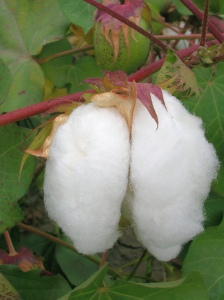 Cotton textile manufacturing is generally recognized as one of the oldest and most important industries in history. Historians trace it to the beginning of various civilizations – dating back at least 8000 years in Mexico and Peru and 5000 years in East Africa and Southern Asia.
Cotton textile manufacturing is generally recognized as one of the oldest and most important industries in history. Historians trace it to the beginning of various civilizations – dating back at least 8000 years in Mexico and Peru and 5000 years in East Africa and Southern Asia.
Of the ancient civilizations in the latter region (East Africa and Southern Asia), India lead the way in the growth of cotton and development of cotton fabrics, and coincident with that, developed a flourishing trade in cotton fabrics with nearby countries including Greece, Egypt, the Roman Empire, along with others. Then continuing for centuries, it remained dominates in the production of cotton fabrics as it provided clothing for most of the Old World.
Pima cotton (Gossypium barbadense) is a tropical, frost-sensitive perennial plant that produces yellow flowers and has black seeds. It grows as a small, bushy tree and yields cotton with unusually long, silky fibers. The name Pima was applied in honor of the Pima Indians, who helped raise the cotton on USDA experimental farms in Arizona in the early 1900s. The first clear sign of domestication of this cotton species comes the Early Valdivia phase site of Real Alto on the coast of Ecuador (4400 BC) and from Ancon, a site on the Peruvian coast, where cotton bolls dating to 4200 BC were found. By 1000 BC, Peruvian cotton bolls were indistinguishable from modern cultivars of G. barbadense. Cotton growing became widespread in South America and spread to the West Indies, where Christopher Columbus encountered it. Cotton became a commercial plantation crop tended by slaves in the West Indies, so that by the 1650s, Barbados had become the first British West Indies colony to export cotton.
 In about 1786, planting of Sea Island cotton, G. barbadense, began in the former British North American colonies, on the Sea Islands of South Carolina and Georgia, when cotton planters were brought over from Barbados. Among the earliest planters of Sea Island cotton in America was an Englishman, Francis Levett, who later fled his Georgia plantation at the outbreak of the American Revolution and went to the Bahamas, where he attempted to introduce cotton production, but failed. Sea Island cotton commanded the highest price of all the cottons, due to its long staple (1.5 to 2.5 inches, 35 to 60 mm) and its silky texture; it was used for the finest cotton counts and often mixed with silk. It was also grown on the uplands of Georgia, where the quality was inferior, and was soon surpassed in commercial production by another native American species, upland cotton (Gossypium hirsutum), which today represents about 95% of U.S production.
In about 1786, planting of Sea Island cotton, G. barbadense, began in the former British North American colonies, on the Sea Islands of South Carolina and Georgia, when cotton planters were brought over from Barbados. Among the earliest planters of Sea Island cotton in America was an Englishman, Francis Levett, who later fled his Georgia plantation at the outbreak of the American Revolution and went to the Bahamas, where he attempted to introduce cotton production, but failed. Sea Island cotton commanded the highest price of all the cottons, due to its long staple (1.5 to 2.5 inches, 35 to 60 mm) and its silky texture; it was used for the finest cotton counts and often mixed with silk. It was also grown on the uplands of Georgia, where the quality was inferior, and was soon surpassed in commercial production by another native American species, upland cotton (Gossypium hirsutum), which today represents about 95% of U.S production.
Extra-Long Staple (ELS) cotton has been grown in the Southwest United States since the early-1900’s, but it wasn’t until mid-century that much attention was given to the new cotton. The real breakthrough came in 1951 when a seed was developed and introduced that produced an ELS cotton with superior fiber properties, luster and silkiness…as well as an unusually high yield.
 Subsequent variety releases in the 1970’s, 80s and 90’s included Pima S-5, S-6 and S-7, all of which boasted higher yields and better spinning characteristics.The name “Pima” was applied to ELS cotton (previously called American-Egyptian) being developed in the U.S. desert southwest in the early 1900’s. The name was given in honor of the Pima Indians who were helping to raise the ELS cotton on the USDA experimental farm in Sacaton, Arizona. The first successful crop of Sea Island was produced by William Elliott on Hilton Head Island, South Carolina in 1790. Although production of this ELS cotton later expanded into the interior regions of Georgia and Florida, the best Sea Island cottons were grown on the Sea Islands; James, Edisto, John and Wadmalaw.vii The crop continued until 1920, when a severe boll weevil infestation had made it unprofitable. Attempts to revive the Sea Island industry in the U.S. in the 1930’s failed.
Subsequent variety releases in the 1970’s, 80s and 90’s included Pima S-5, S-6 and S-7, all of which boasted higher yields and better spinning characteristics.The name “Pima” was applied to ELS cotton (previously called American-Egyptian) being developed in the U.S. desert southwest in the early 1900’s. The name was given in honor of the Pima Indians who were helping to raise the ELS cotton on the USDA experimental farm in Sacaton, Arizona. The first successful crop of Sea Island was produced by William Elliott on Hilton Head Island, South Carolina in 1790. Although production of this ELS cotton later expanded into the interior regions of Georgia and Florida, the best Sea Island cottons were grown on the Sea Islands; James, Edisto, John and Wadmalaw.vii The crop continued until 1920, when a severe boll weevil infestation had made it unprofitable. Attempts to revive the Sea Island industry in the U.S. in the 1930’s failed.
 The evolution of ELS cottons began in 1825 when Sea Island cotton was brought into Egypt and crossed with a tree cotton named Jumel. The crossing of Jumel and Sea Island resulted in the development of Ashmouni in about 1860. The next several Egyptian cultivars were derived either by selecting within Ashmouni or from crosses of Ashmouni and Sea Island. The successful utilization of inbreeding between the years 1910 and 1940 led to the gradual development of Egyptian cottons that could compete with the quality of Sea Island.viii (It’s important to note here that during the development of these later cottons, no germplasm from outside Egypt was used.)
The evolution of ELS cottons began in 1825 when Sea Island cotton was brought into Egypt and crossed with a tree cotton named Jumel. The crossing of Jumel and Sea Island resulted in the development of Ashmouni in about 1860. The next several Egyptian cultivars were derived either by selecting within Ashmouni or from crosses of Ashmouni and Sea Island. The successful utilization of inbreeding between the years 1910 and 1940 led to the gradual development of Egyptian cottons that could compete with the quality of Sea Island.viii (It’s important to note here that during the development of these later cottons, no germplasm from outside Egypt was used.)
Source: jimmy Wales – Narvell Strickland – supima.com
Information:http://www.ogtr.gov.au/internet/ogtr/publishing.nsf/Content/cotton



























Pingback: Cottoning On: Reading (and Understanding) the Label on Your Cotton Goods